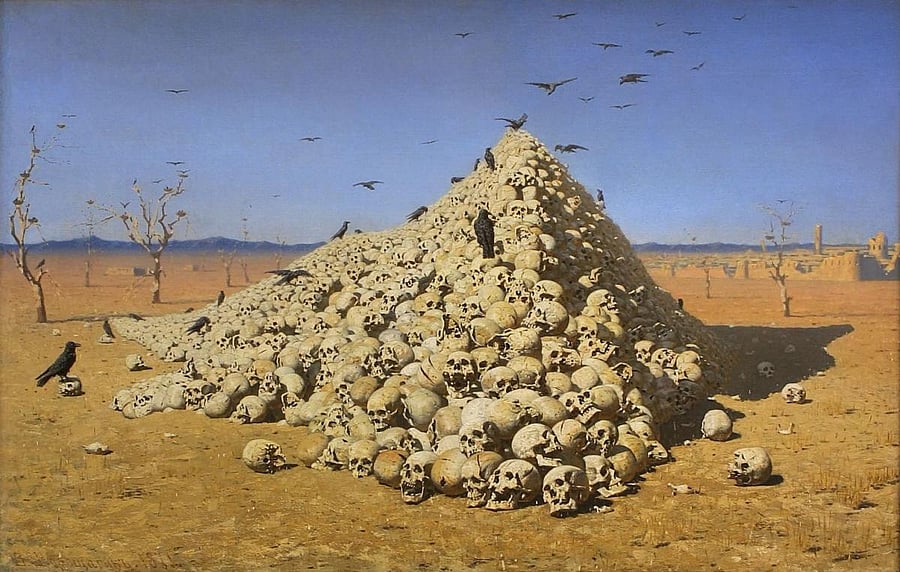
Artists across the world have always reacted to wars, invasions, and military conflicts with angst and anger. In the backdrop of the Russian ‘special military operation’ in Ukraine, many anti-war images painted by famous artists over time flash through one’s mind.
On top of the list would be Pablo Picasso’s Guernica (1937) often regarded as the most powerful anti-war painting of the 20th century. It is well known that the Spaniard (who had been in exile in France since 1901) painted the large 11 feet by 25 feet canvas in response to the destruction of the town of Guernica in northern Spain by Nazi bombers on 26 April 1937. With a plethora of signs and symbols aimed at conveying human suffering, pain, misery, and death, the monochromatic painting is also seen as the artist’s protest against the indiscriminate mass killing of civilians by men in power.
Interestingly, some of the most evocative anti-war paintings were created by Russian artists in the past. Among the scores of such images is Vasily Vereshchagin’s ‘The Apotheosis of War’ painted way back in 1871. The unsettling work shows a massive pyramid-like pile of human skulls in the middle of a barren desert. A ruined city in the background and a flock of dark, hungry, and menacing birds fluttering over the pile heighten the tragic tone of the picture. The painting was inspired by (and originally named after) Tamerlane (Timur), the 14th-century Mongol ruler of Samarkand known for his gruesome military campaigns and bloody invasions which had resulted in the slaughter of millions of people. The Turkish Mongol conqueror Tamerlane had made it a custom to leave a pyramid of the heads of victims on the outskirts of the conquered cities.
First-hand impressions
Vereshchagin (1842–1904) is remembered to this day for his authoritative and authentic portrayal of battle scenes. Born in the town of Cherepovets (about 500 km from Moscow), and having attended the Marine Military School in St Petersburg as a teenager, Vereshchagin’s first taste of war came in 1867-68. The 26-year-old youth accompanied the Russian Army on an expedition to modern-day Uzbekistan as a volunteer. Holding the rank of a junior officer he witnessed and sketched first-hand impressions of war. The experience left a deep impression on the young soldier-artist and helped him engage himself in realistically painting the battle scenes.
Vereshchagin continually travelled to areas of conflict not only to observe but also to actively participate in military manoeuvres. “It would be impossible,” he wrote, “to
achieve the aim I have set myself, to give society a picture of war as it really is, by observing battles through binoculars from a comfortable distance. I have to feel and go through it all myself. I have to participate in the attacks, storms, victories and defeats, experience the cold, disease and wounds. I must not be afraid to sacrifice my flesh and my blood, otherwise my pictures will mean nothing.”
Vereshchagin’s images showed in great detail both the triumphs and defeats of armies and more importantly, the tragic fate of soldiers. He often depicted common soldiers, not as triumphant heroes but victims and puppets of barbarous generals on the battlefield. The ‘Turkestan series’ painted based on sketches and studies done during the war brought him considerable fame and recognition. At the same time, some of his paintings were censored by the authorities for the brutally frank portrayal of life on the battlefield and for showing the Russian army in a poor light.
One of the first Russian artists to be widely recognised and exhibited abroad, Vereshchagin was an indefatigable traveller and a prolific author of insightful travel books. Among the countries he visited were China, Japan, America, the Philippines, Cuba, Syria, and Palestine. He was known to possess ‘a robust figure with broad shoulders, bushy black beard, and a benevolent-looking face’; his conversations
were always ‘interesting, original, articulate, frank, affable, and unaffected’.
As in life, Vereshchagin’s death was also linked to war. He was aboard the Russian flagship ‘Petropavlovsk’ taking part in the battles of the Russo-Japanese war. On
April 13, 1904, the ship struck two mines and sunk. Vereshchagin, along with most of the crew on the ship, drowned to death.
Although he participated in military operations, Vereshchagin always maintained an anti-war stance in his work. More than a century ago, he wrote: “Does war have two sides — one that is pleasant and attractive and the other that is ugly and repulsive? No, there is only one war, that attempts to force the enemy to kill, injure, or take as many people prisoner as possible, while the stronger adversary beats the weaker until the weaker pleads for mercy.”
Indian connection
Vereshchagin made two trips to India — in 1872-74 and 1882-83. He travelled all over India particularly Rajasthan, Gujarat, Delhi, Bombay, Ladakh, and the then independent kingdom of Sikkim. He made a large number of sketches and paintings of varying subjects — architectural monuments; Buddhist temples and monasteries; mosques and minarets; and portraits of the nobles and commoners.
He seemed to love the Himalayas and extensively toured and painted the mountainous terrain. His paintings of the Taj Mahal and Delhi’s Moti Masjid are hailed for their sensitive handling of colours and moods, besides attention to detail. His epic portrayal of ‘The State Procession of the Prince of Wales into Jaipur’ in 1876 is regarded to be the third-largest painting in the world.
Vereshchagin made several paintings showing how Indians were subjected to tyranny by the British colonialists. ‘Blowing from Guns in British India’ is a horrific image showing British soldiers executing men tied to the barrels of cannons.